Daniel Arsham is an artist unencumbered by the conventions of a particular place or period. Indeed, the very nature of his work and his audience’s connection to it suggest that the lines of what constitute “proper” art and even time itself seem to bend around him. From the comfort of his New York-based studio, he shares about his extensive use of social media to communicate with an audience beyond the traditional art world and his role as an artist reshaping culture.
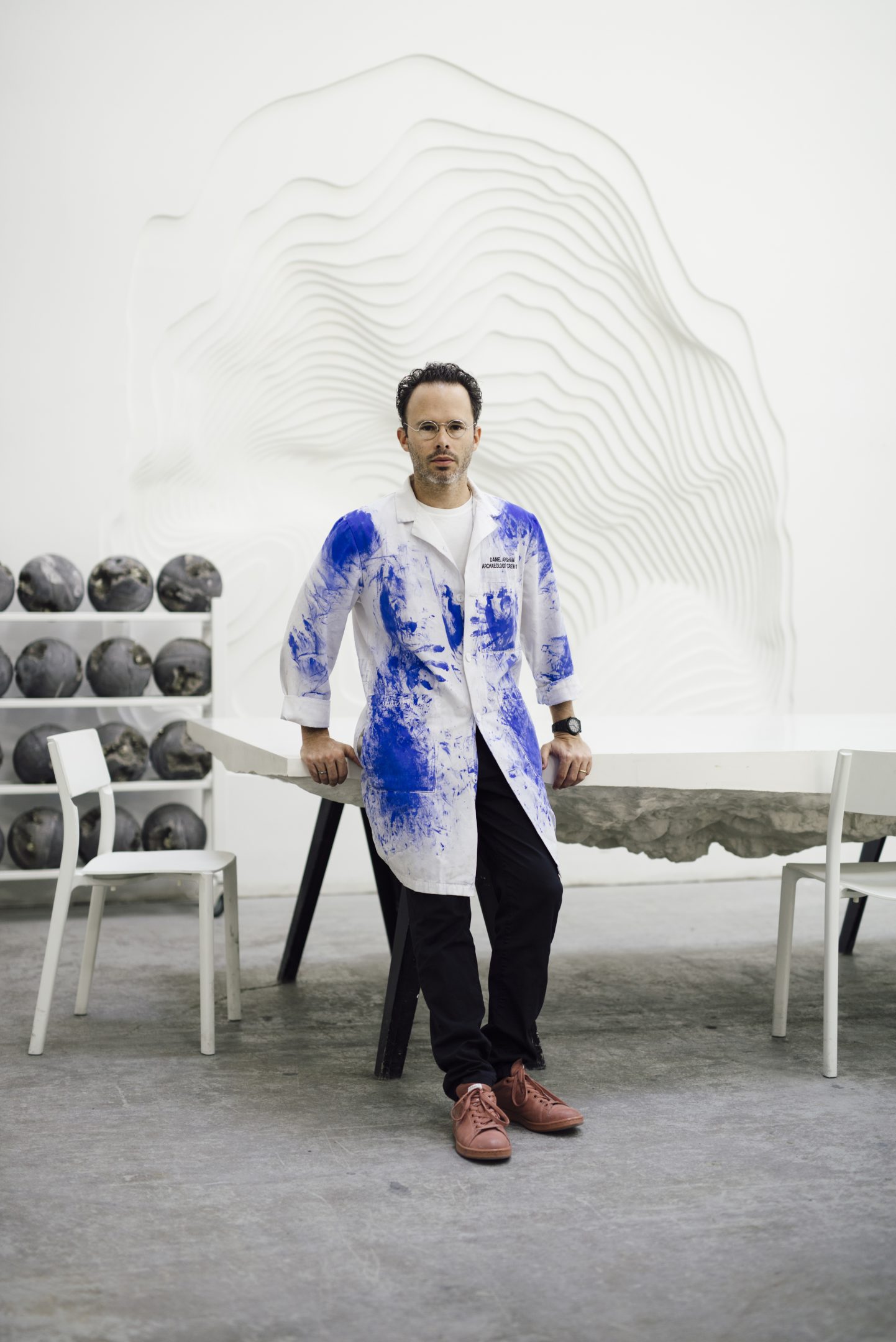
Arsham in his Long Island City Studio.
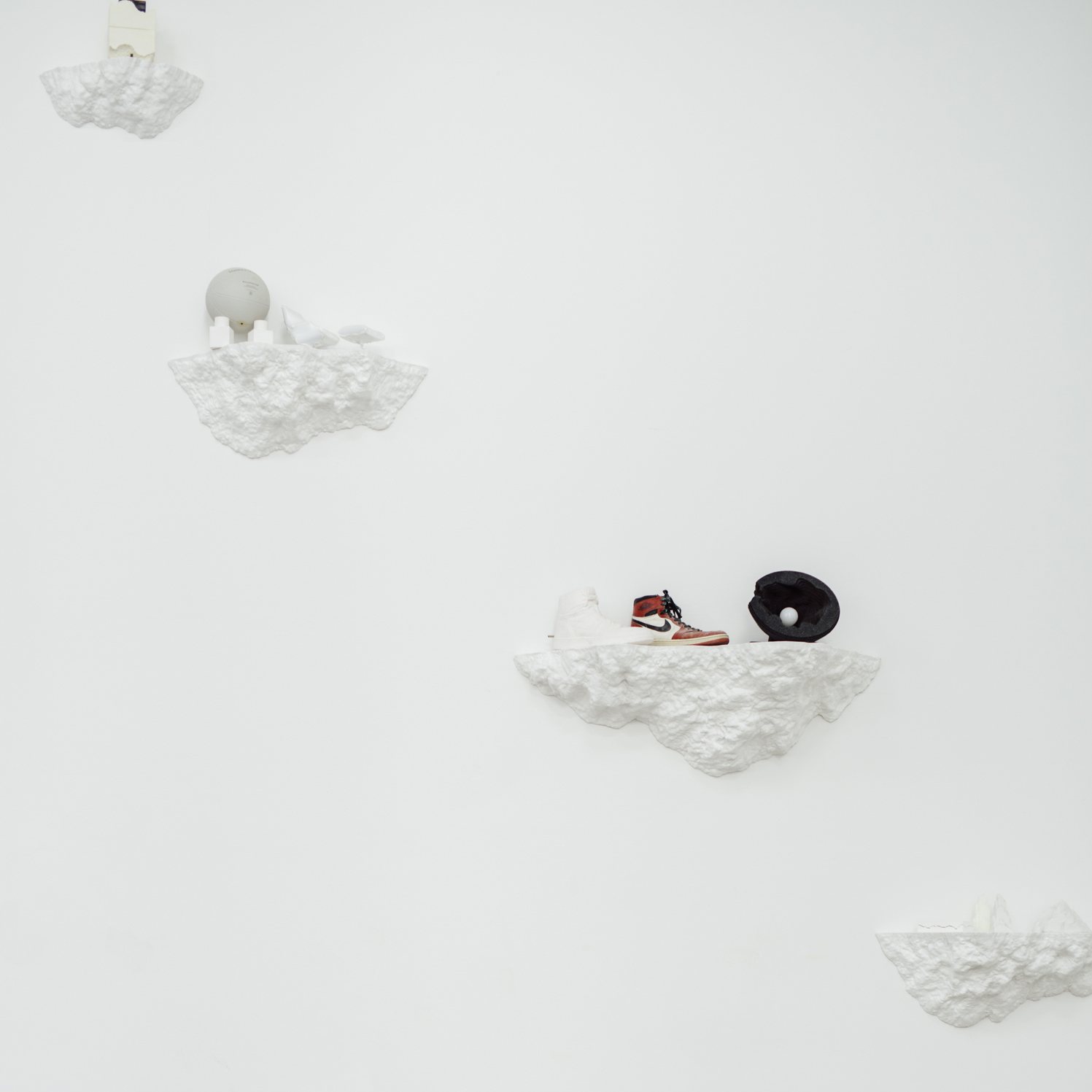
“The fact is, the Time Traveler was one of those men who are too clever to be believed; you never felt that you saw all around him; you always suspected some subtle reserve, some ingenuity in ambush, behind his lucid frankness.”
— H.G. Wells, The Time Machine
At the end of a particularly long dockyard warehouse in Long Island City, New York, past a loading dock and through a chain link gate, there sits a gray door with a metal disc that has the word “STUDIO” faintly stenciled onto it. The orderly clutter of the space behind that door feels as much workshop and storage space as it does a studio. On the upper walls, curiously, a basketball hoop and backboard hang opposite a typical high school gymnasium scoreboard. Below, the lower walls are surfaced with plywood organizers for hanging power tools and drawers of small hardware. Wooden pallets and bound piles of collapsed cardboard boxes are neatly stacked in the corners. The work tables in the center of the room, stained with a dusting of purple and blue pigments, are messy with hand tools and opened plaster molds, strewn about like spent mortar casings.
Through the rear door, you enter a small alcove with lockers. Comparatively clean and uncluttered, it feels, for a moment, like passing through a space station airlock. On the wall to the left, a black felt letterboard reads “WELCOME TO THE FUTURE.”
In the next room are heavy, ashen casts of faux artifacts and white plaster walls interrupted by recessed topographic maps, precipice-like outcroppings doubling as shelves and the protruding form of a person wrapped in the “fabric” of the wall surface. The surfaces of the low-standing bookcases, shelves, and office desks that divide the room are all dotted with sculptures, works-in-progress, tools, random cultural ephemera, and carefully pruned bonsai.
Library quiet but lit by dramatic cascades of sunlight through glass pyramids in the 20-foot ceilings, the room is a Dali-esque, surrealist landscape projected in white. And like the many monolithic sculptural and architectural projects of their creator, the protean and peripatetic artist Daniel Arsham, it is a visually arresting Instagram-ready dream—one that is in more ways than one a particular vision of the future.
In the quiet of his studio, Arsham seems to exist out of time. Wearing a white lab coat streaked with blue paint and embroidered with the facetious title “Archaeology Crew Chief,” he looks like a time-slipped Erwin Schrodinger as he navigates the room, chatting with his staff in deliberate, measured speech. But surrounded by the uncanny valley of his art and describing new media techniques he’s developing, he seems like a time traveler whose stories you suspect you can’t fully believe.
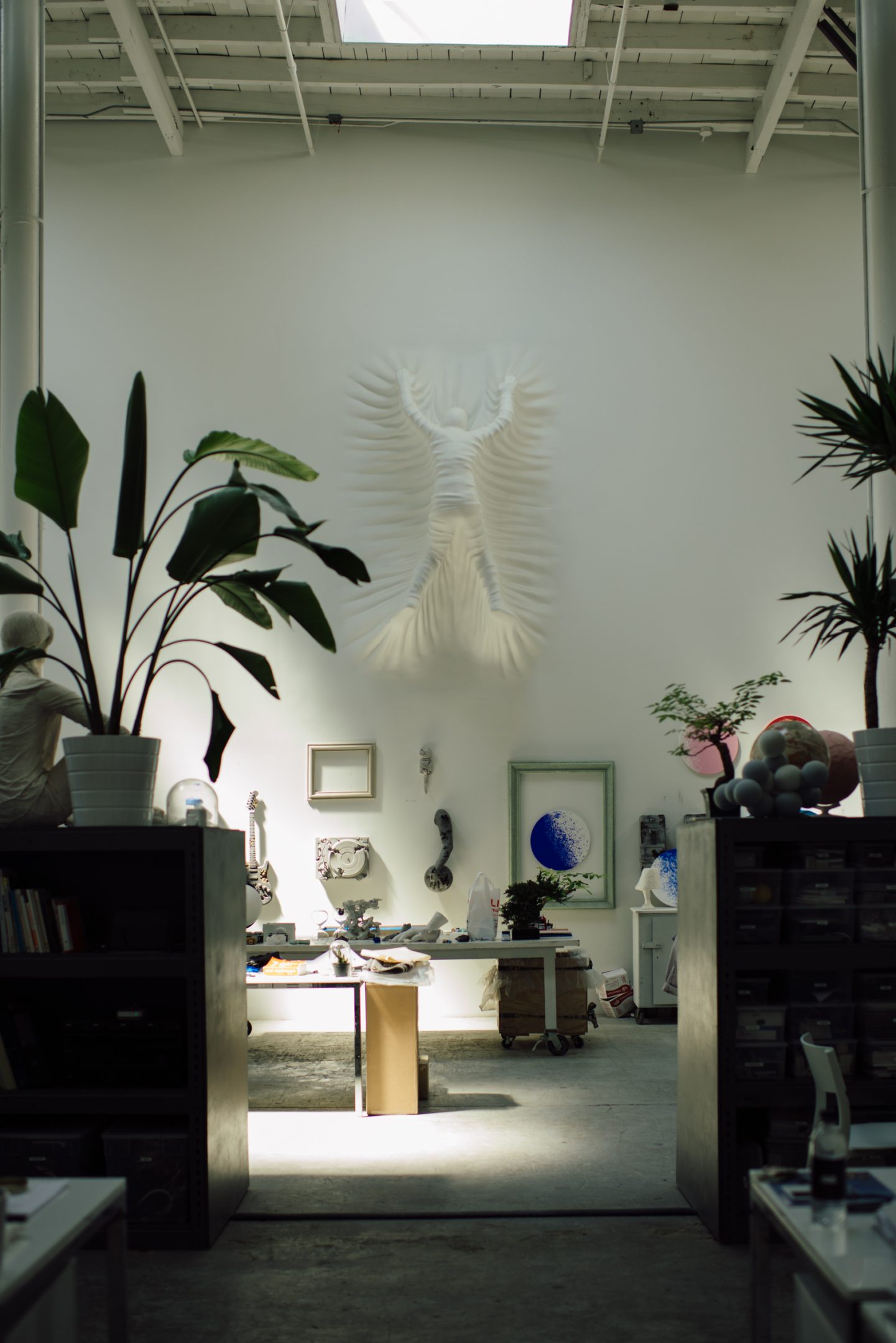
The curious drama of the main hall of Arsham’s studio.

Casts of sports objects for Arsham’s New York exhibition at the Galerie Perrotin.
Like most old-world institutions, the art world is ingrained with a cultural conservatism that fears the future. For the better part of this millennium, those fears have been increasingly stoked by the emergence of social media as the brutal new gravity of its sudden and rapid approach has pulled, warped and, at points, fractured the art world along every conceivable sightline.
The commensurate reactions have alternated between a New World explorer’s raw wonder and panicked self-flagellation. Is social media really a democratizing voice in the validation of art, or is the “app-as-arbiter” model unintentionally prioritizing hype and photogenic shareability? Does art benefit from social media’s ability to demystify and broadcast to a wide audience, or does it suffer from an increasing lack of nuanced discussion and social media’s sometimes arbitrary censorship? Has social media given artists a direct method of reaching a new generation of collectors, or has it made art dangerously commodified and transactional? Is it a promotional tool for the gallery, or has it superseded the gallery itself? Is it a way for artists to have their art seen or stolen?
An experience chronicled by revered New York Magazine art critic Jerry Saltz suggests that the answer to all of these questions is usually a gray area “yes”: In a three-month span starting in December 2014, he went from waxing poetic about discovering emerging artists on Instagram to wailing at having his Facebook account banned after users complained about images of Medieval artwork he posted. This debate can be multi-faceted, yet also seems decisively silenced by an overwhelming sense of futility. You can’t always fight a new reality; sometimes you can only adapt.
Daniel Arsham, whose work is a dialogue between our recent past and a far-flung fictional future, does not need to adapt to our present reality. On the contrary, he seems purpose-built for a world where the clean lines that determine what art is, where it can occur and who has access to it, are blurring and dissolving. His primary concern is—and always has been—his audience. His approach to finding his audience represents a model for how to thrive in the new normal.
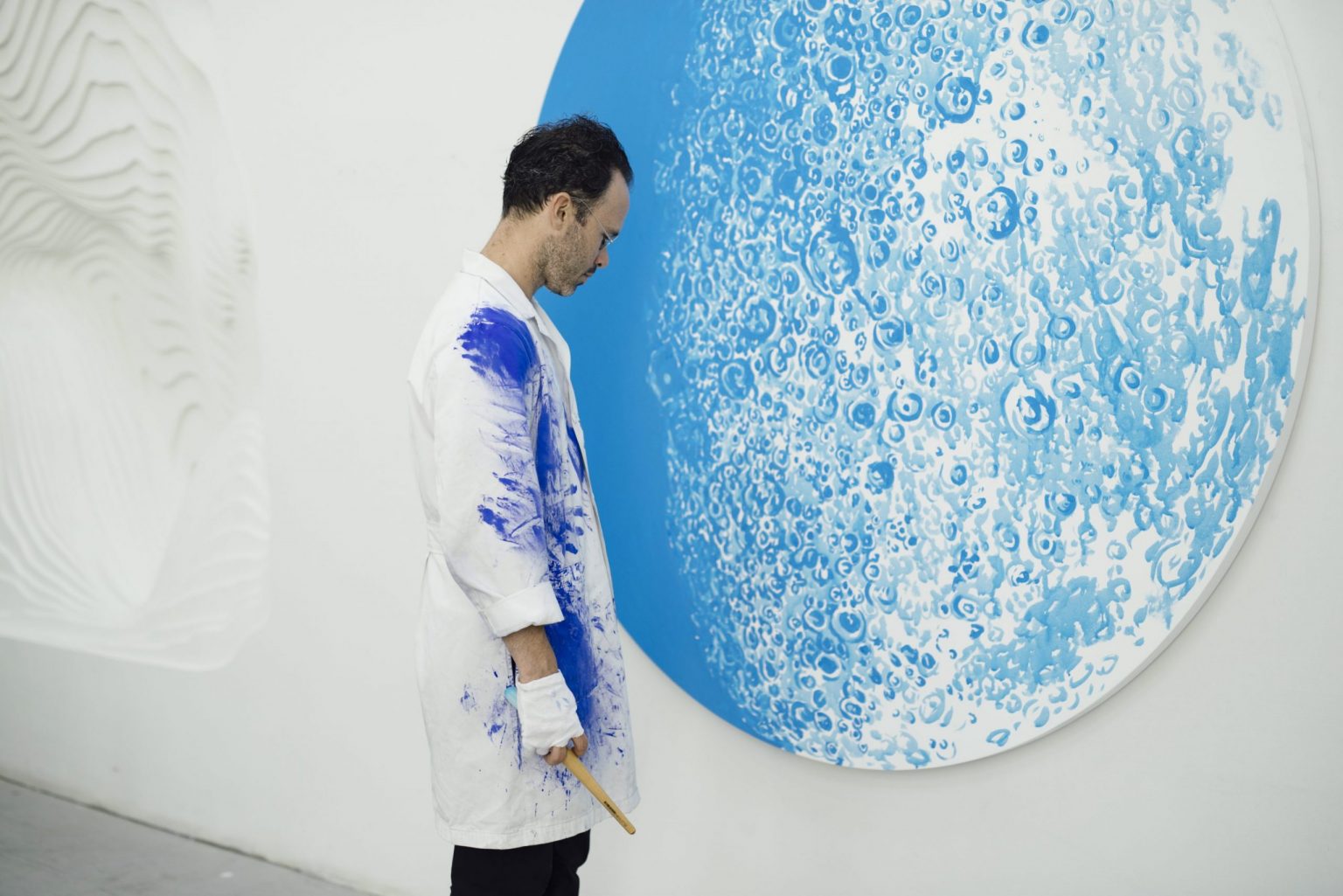
Arsham at work on a piece centered on one of his longest standing subjects, the moon.

An installation of ping pong ball clouds in the studio’s main hall.
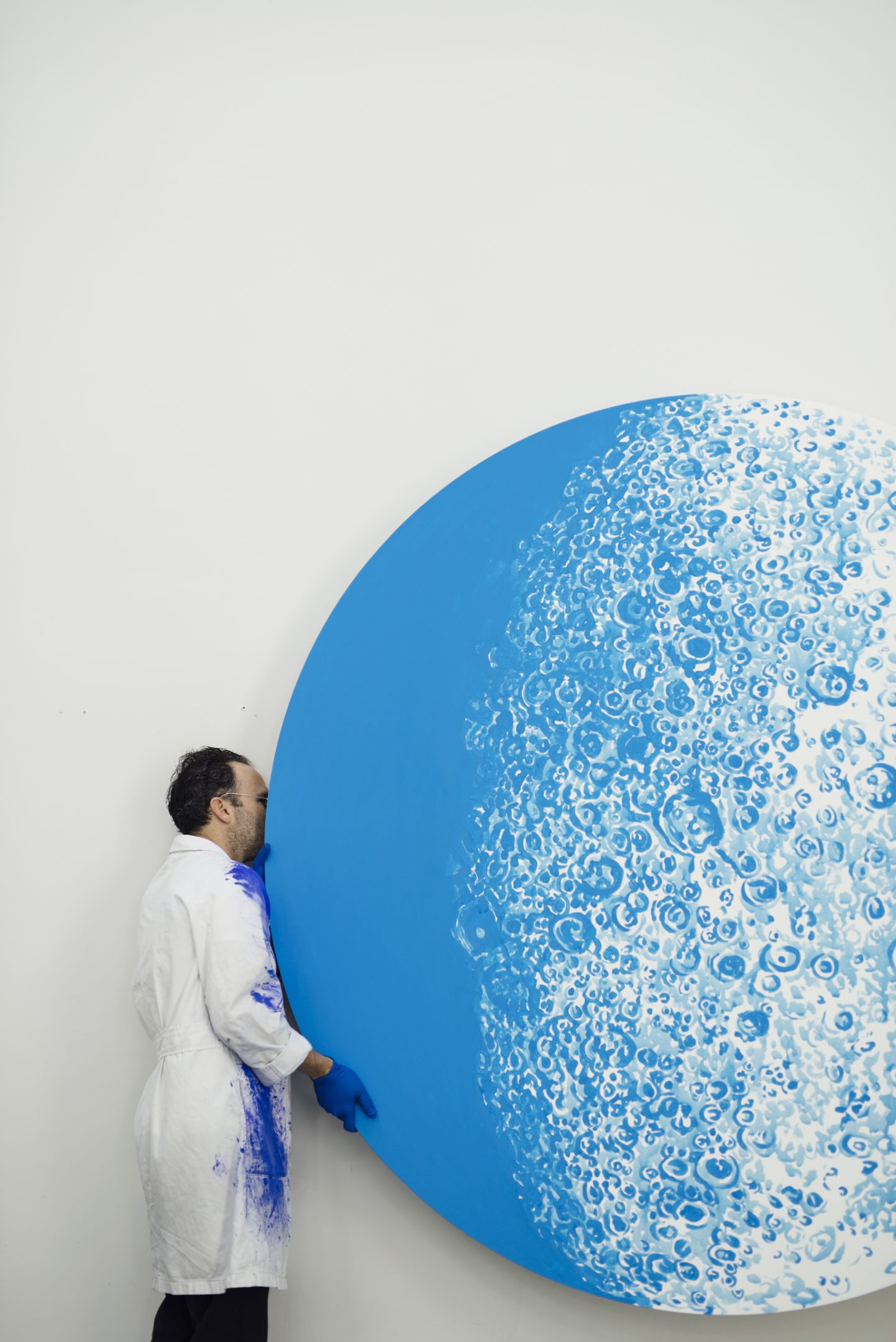
It’s a safe bet that most of Arsham’s admirers have never seen his work in person. While he’s exhibited in Miami, Cincinnati, Hong Kong, Paris and most recently New York, and co-designed the interiors of some of Los Angeles and New York’s most trafficked retail spaces, it’s still more likely that his quarter million social media followers have only seen his work through his Instagram or Snapchat, on the accounts of his celebrity friends, in one of his short films, or on the cover of Usher Raymond’s new album Hard II Love.
This is, in a sense, by design. Arsham has always sought an audience beyond the traditional art world, which he says can “sometimes can be quite insular and intimidating to certain audiences.” He is a ray of light in search of prisms that will diffuse his vision to the widest audiences possible. It’s an approach whose resultant impact can dwarf the truth of its small footprint. Case in point: His recent exhibition at the Galerie Perrotin in New York was his first solo exhibition in his adopted home city. The overarching reaction? Genuine surprise.
One such prism that Arsham uses is his multidisciplinary practice. He constantly evolves and innovates, sliding from fine art to film to performance to collaboration to commercial projects. “For me, all audiences are important, and I think one of the things that I have tried to do in my work in terms of spreading out the areas in which I work is to reach different audiences,” he says. In turn, he hopes his efforts have a kind of unifying effect, noting that “in some ways, the kind of broad nature of my work encourages people to think about dance or architecture or painting and sculpture all in the same way. That they’re all accessible to them.”
Another is social media. The particular interplay between his work and that medium could launch a thousand art school papers. For instance, his work depicts the excavation of iconic remnants from the era when man worshiped consumer goods; an era arguably ended by the current one where man instead worships the very social media tools he used to record the creation of said work. Despite its ability to elevate any artist’s presence, he largely avoided social media until June 2012 when he began using Instagram. “Instagram sort of fit into my everyday practice. And I think that one of the things that I like about it is it allows audiences who wouldn’t otherwise find my work to see it.” He recounts discovering he had a huge following in Mexico he would have been oblivious to without it.
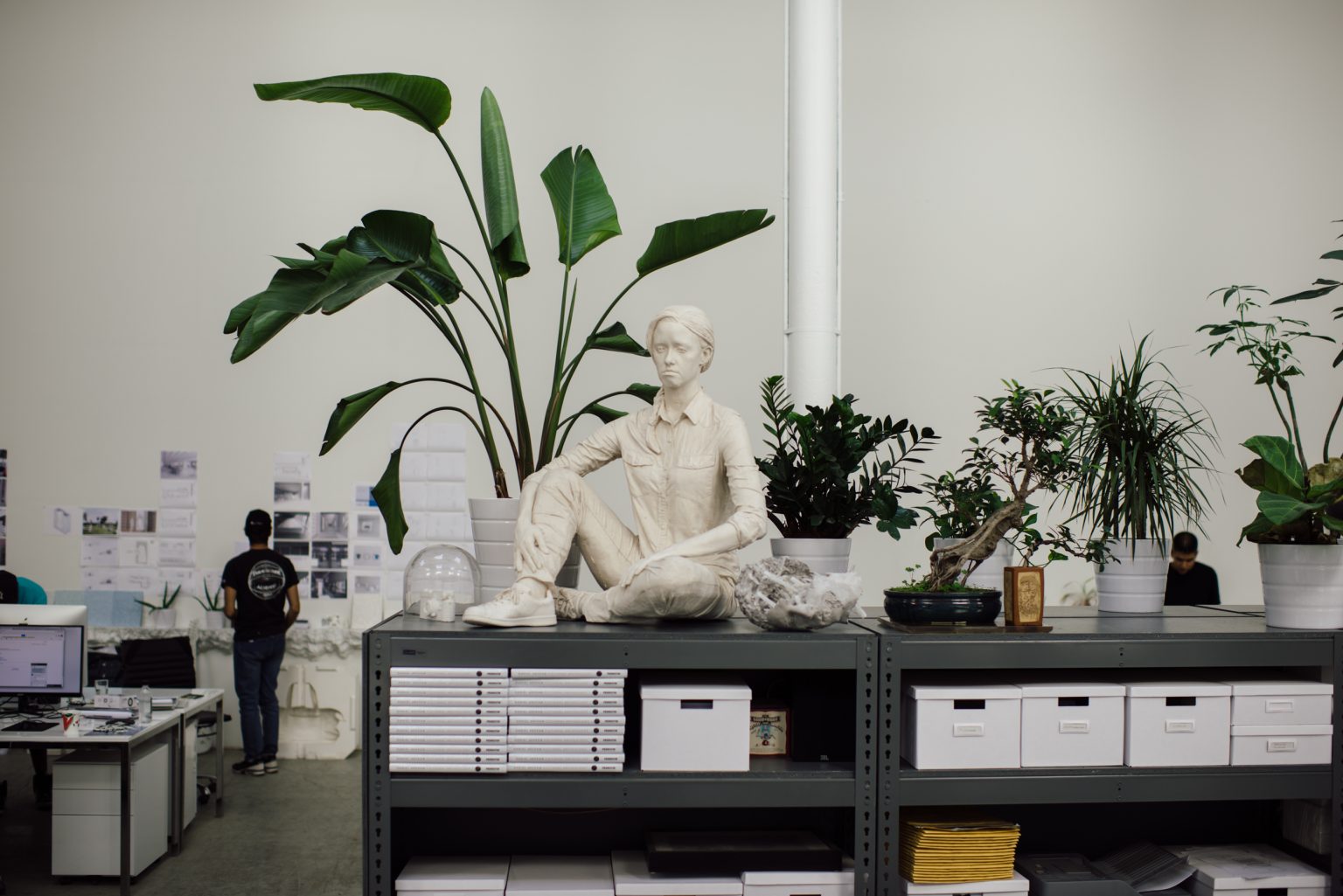
Of course, social media’s omnipresence was not a prerequisite for Daniel Arsham’s existence. Multidisciplinary practice and art that interrogates pop culture are obviously not new concepts. “You know, I think that I would have [always worked this way]. I started working in this way before social media existed,” he argues plainly. Indeed, his contemporary artistic identity existed whole cloth before social media’s ascendance, when he first began experimenting and collaborating across disciplines after being plucked from relative obscurity by Merce Cunningham in 2004. His fated trip to Easter Island in 2010 catalyzed his fascination with a faux archaeology focused on commercial iconography, two years before he first posted to Instagram.
He deliberately uses Instagram to deepen his audience’s relationship and understanding of his work; he offers his sculptural projects, often cast in uncommon materials like volcanic ash or crystal, as an illustrative example. “I think that the choice of materials for those works—the kind of material quality—is in some ways as important as how they look for their meaning,” he says. “Knowing that the thing is made of volcanic ash physically gives this kind of material truth to it, and teasing that out through images posted on social media I think broadens that experience for people.”
It’s also given him a space to show a critical and personal part of his creative process—his photography. Arsham’s creative first love after receiving a camera from his grandfather at 12, photography was (until his adoption of Instagram) the one medium he worked in regularly but had never shown publicly.
“It’s an outlet where [the photographs] are not for sale; I’m not trying to do anything with them. It’s really just to show them to the public.” Sharing it publicly has had the unintended side effect of feeding back into his art. “I think it has probably encouraged my use of my photography in relation to my other work because I’m just thinking about it more and I’m seeing it more, whereas before I would be shooting and then it would go into my archive.” He notes a series of recent moon paintings in particular as being influenced by the long exposure night photography he’s been experimenting with.
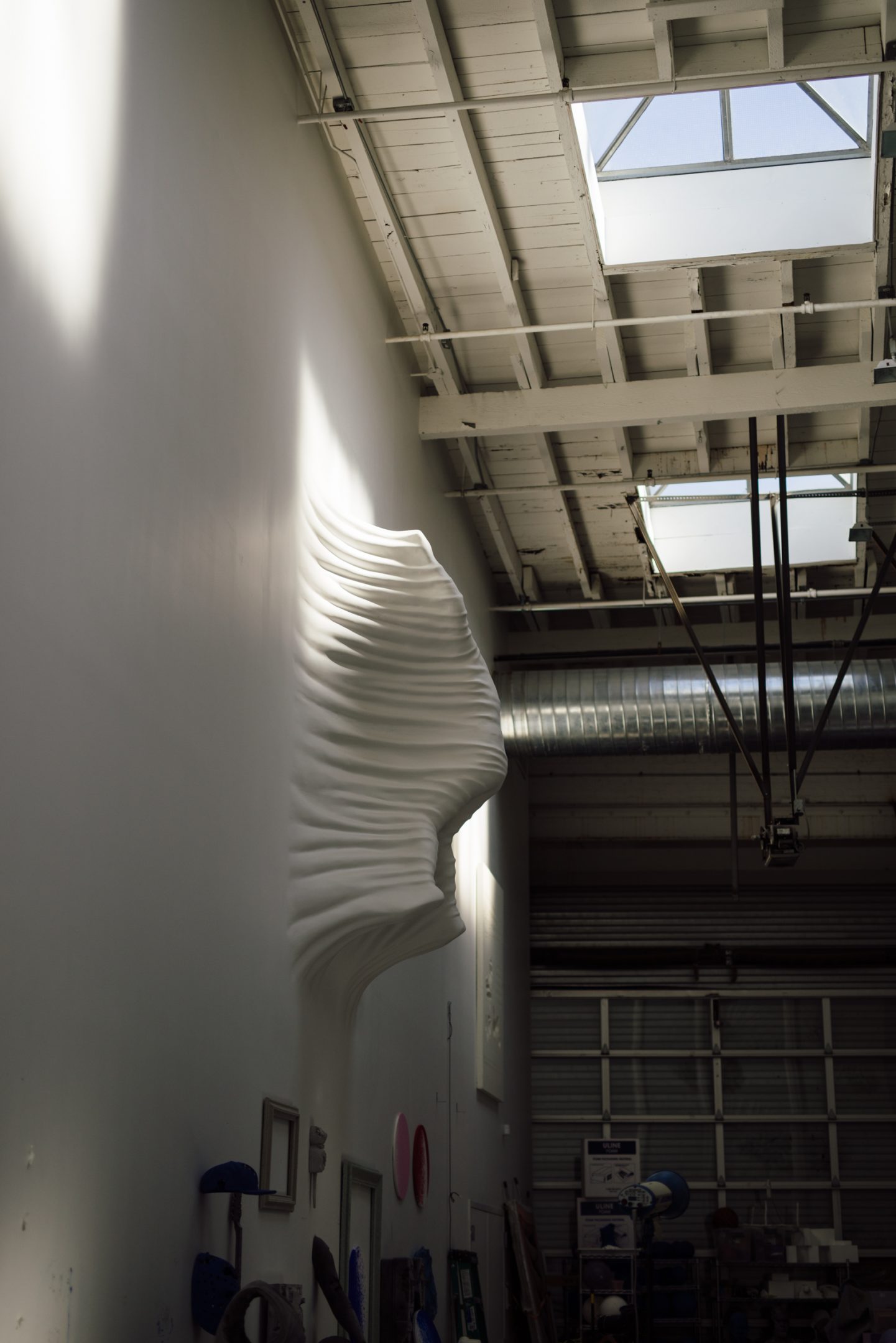
Arsham’s art often excludes directly depicting people, instead choosing to at most imply the shape of a human figure.
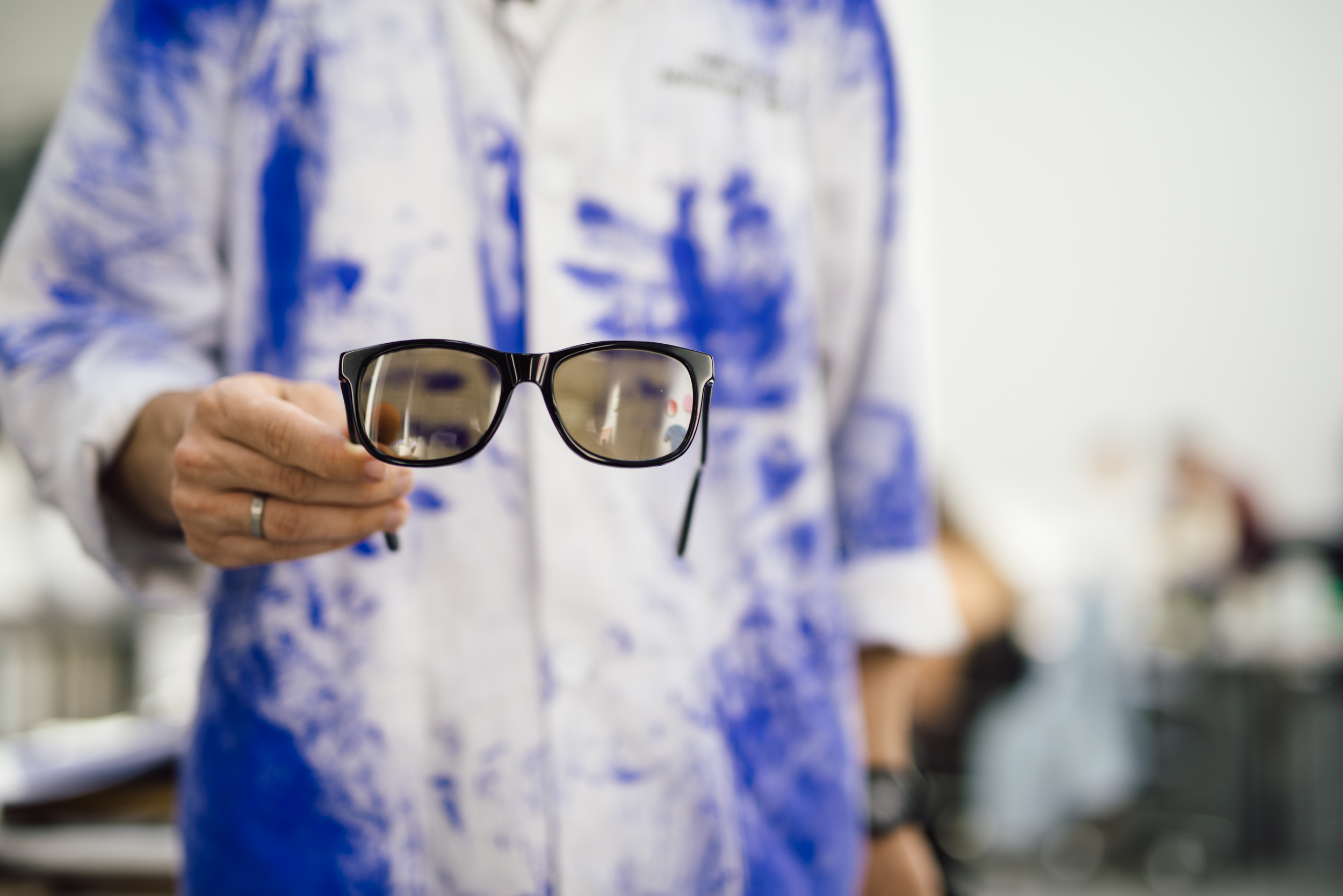
Through the help of EnChroma glasses, an otherwise color-blind Daniel can see color.
It extends beyond simply sharing his work and work process. He also posts in an offhand manner about seemingly whatever strikes him in the moment, whether it be his current projects, his wife and kids, his friends (famous or otherwise), his staff, his shows, his shoes, his constant travels and his workouts. He shares seemingly everything. He is habitually prolific, and the sheer volume of his activity is impressive.
This extensive sharing can actually, at times, feel vital to processing his work. While Arsham’s fictional archaeological relics carry a cold, desolate detachment and a static visual weight that masks their inherent playfulness, the lighthearted, dynamic and capricious human behind the social media accounts serves as a counterweight.
It’s also through his social media that he has communicated a broader, intangible meaning of “human” that permeates his art: With few exceptions, Daniel very rarely features human figures in his work beyond the shape of a body implied in the drape of a sheet, or the hang of a jacket. It’s an approach he’s used for years. “If you look back at paintings that I made, even as early as works that I made in school, they never contained people in them. And part of the reason I inherently didn’t do that is I felt that it locked it into a certain time period by the way they dressed or the way their hair was cut.”
“My job as an artist is to kind of digest culture and put back another version of it that’s my kind of version or my vision of it, or allow people to rethink their everyday experience and show them something that was always there in a new way.”
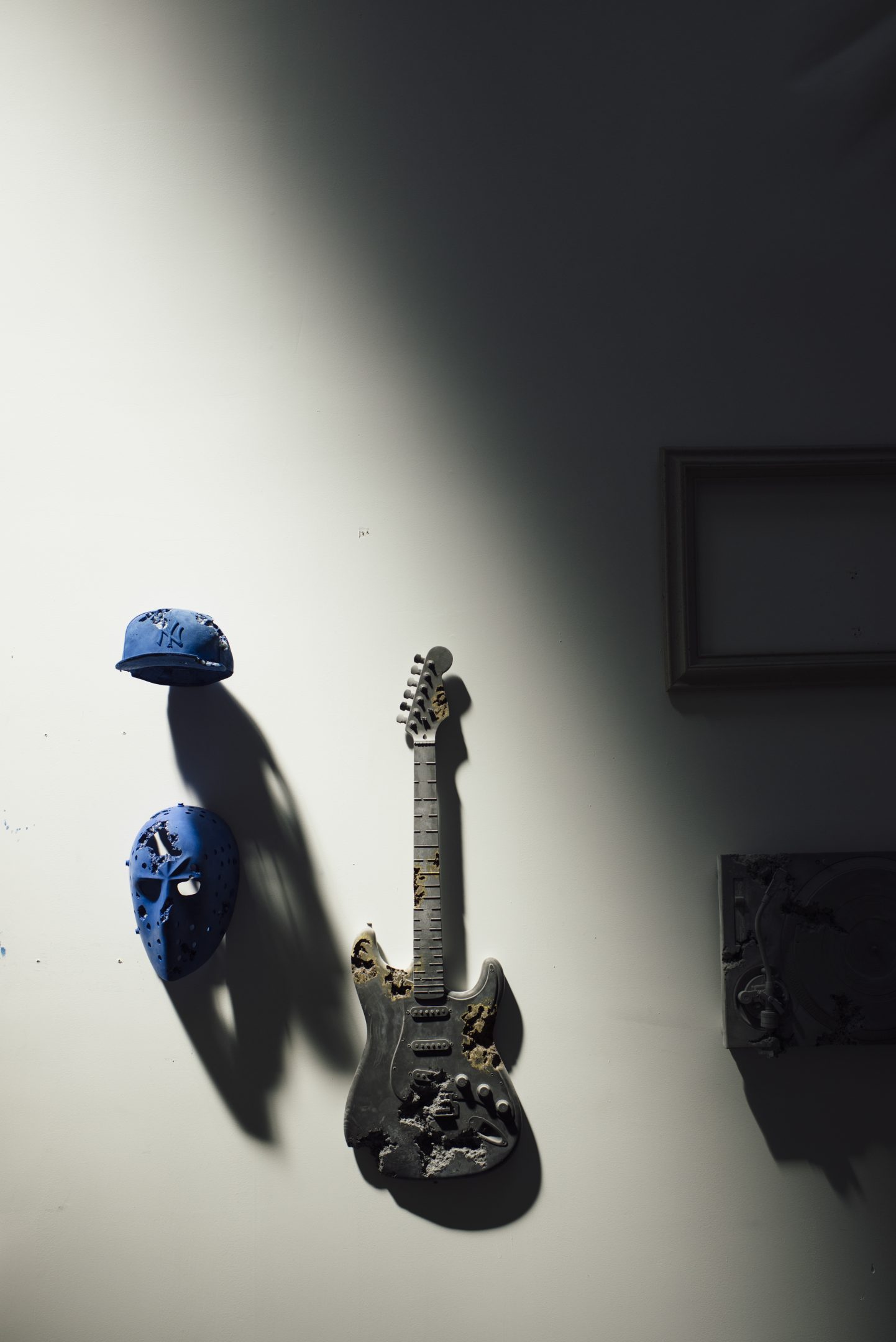
Relics of Arsham’s fictional archeology.

For his sculptural relics, he tries to create a circumstance where iconic objects can be seen with the intellectual distance of a far-off archaeologist. He achieves this temporal disconnect between art and audience by draining each piece of contemporary context and human signifiers: There are no people cast in these sculptures, and they are rendered in unfamiliar materials and monochrome colors. This leaves each object’s pure form to be newly investigated and understood. It’s a thought experiment he puts as “a process of trying to forget.”
But this means, of course, that he needs a human audience and their reaction to this process of forgetting in order to make the art “work.” It’s as though in the course of eliminating people from one side of the canvas, he’s ironically created a deep need for their existence on the other. And he’ll occasionally go so far as to use social media to test for this feedback. “I’ll post stuff if I’m curious for how people are going to react to it. Are they taking away from it the same thing that I’m taking away from it? So it’s useful in that way. It’s like crowdsourcing.”
While this approach might fly in the face of more traditional views on how art should be created, Arsham sees it reasonably as central to his practice. “My job as an artist is to kind of digest culture and put back another version of it that’s my kind of version or my vision of it, or allow people to rethink their everyday experience and show them something that was always there in a new way,” he explains. “In order to do that I need to understand people’s thought processes in terms of how they interpret things. So the feedback that I’m getting—sometimes in person, but often through social media—allows me to better hone how I’m doing that.”
A future, real or imagined, does not radiate any peculiar magic until it is filtered through the lens of the present tense. “You know, there are artists that make work in a room, and they kind of just do that, and they’re fine, and nobody will ever see it. But I don’t,” he pauses. “I need the audience in order to complete the work.” He remains, as always, focused on a future of his own design, dreaming about what it will be, how it will look, and who will join him there.





























